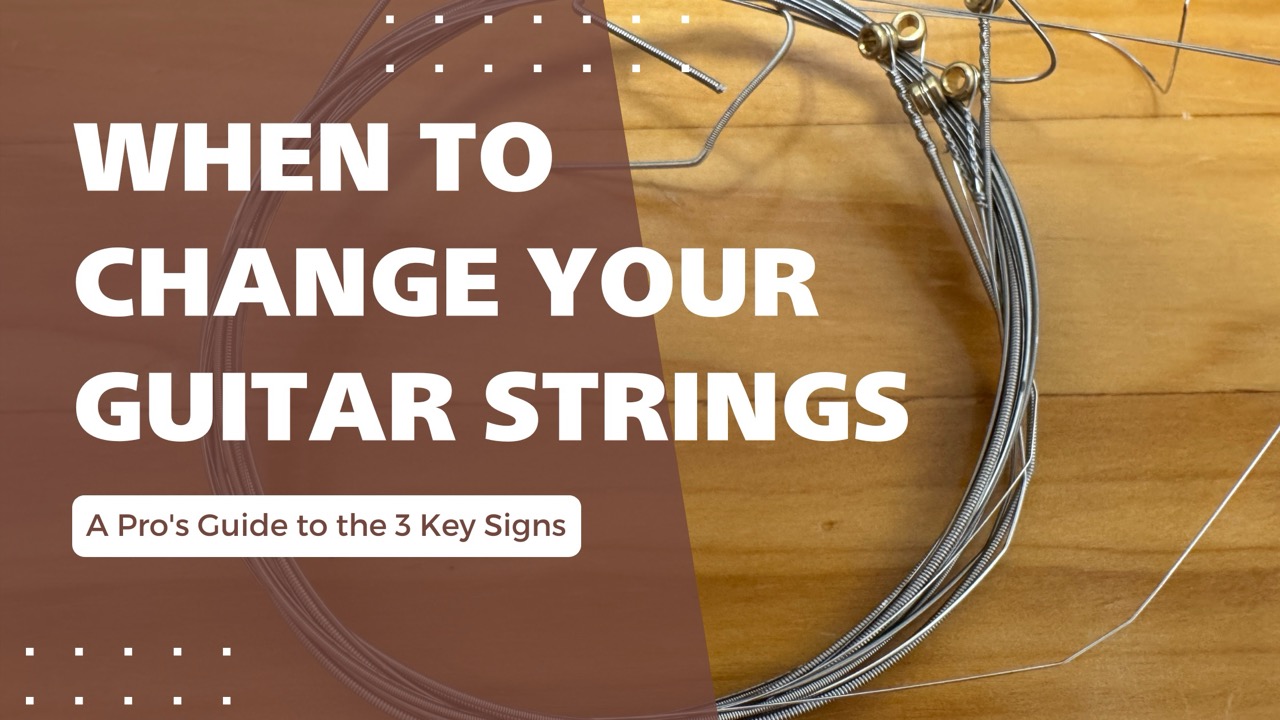When to Change Your Guitar Strings: A Pro’s Guide to the 3 Key Signs
Hello! I’m Shohei Takamura, the founder of Guitar no Shohousen TAKAMURA.
To all the guitarists reading this, I want you to take a moment. Look towards the headstock of your beloved guitar and ask yourself a simple question:
“When was the last time I changed these strings?”
What’s your answer? If you’re thinking, “Hmm, it’s been over a month…” or “Maybe six months ago… or was it longer?”—you’re not alone.
I get it. Playing the guitar is incredibly fun, but changing the strings can feel like a bit of a chore.
But think of it this way: even the most skilled chef can’t create a masterpiece with old, stale ingredients.
For a guitar, the “strings” are just like those “ingredients.” The brilliant, vibrant sound of new strings is the fundamental basis for making the music you play truly delicious and captivating.
In this article, I’m going to give you a straight answer from a pro’s perspective to the common question, “So, when should I actually change my strings?”
- What specifically happens if you don’t change your strings?
- What are the unmissable signs that it’s time for a change?
- What’s the ideal replacement frequency for you?
I’ll break it all down in a simple, easy-to-understand way. By the time you finish reading, you’ll have a clear set of criteria for changing your strings and be ready to unlock 100% of your guitar’s true potential.
Let’s embark on this journey to make your guitar sound its absolute best!
Why Is Changing Strings So Important? The 3 Downsides of Neglect
You might think, “Well, my old strings still make a sound, so it’s fine, right?” While I understand the sentiment, you’re actually doing your guitar a great disservice.
Once you understand the specific disadvantages of using old strings, I’m sure you’ll be thinking, “I need to change them ASAP!”
1. Your Sound Degrades Significantly
This is, by far, the biggest drawback. New strings are rich with pleasant high-frequency overtones—that “sparkle” and “chime.” This is the source of a guitar’s “crispness” and “shine.”
However, as strings age, sweat, skin oils, and metal oxidation cause these overtones to disappear.
- Your tone becomes muffled and lacks presence.
- Your sustain (how long a note rings out) gets shorter.
- Your tuning becomes unstable, no matter how much you adjust it (especially the octave pitch).
If you notice these symptoms, it’s a clear sign your strings have reached the end of their life. Your practice sessions and favorite licks will lose their brilliance.
2. Playability (Feel) Decreases
It’s not just about the sound; your playing experience is directly affected. The surface of old strings becomes rough and corroded from rust, even if it’s not visible to the naked eye.
- Your fingers won’t glide smoothly, making slides and vibrato difficult.
- Pressing down on the strings might feel uncomfortable or even painful.
This can cause you to unconsciously use more force, hindering your fingering. For a comfortable and focused playing experience, string condition is crucial.
3. You Risk Damaging Your Guitar’s Frets
This might sound a bit scary, but it’s true. If you see visible rust on your strings, they’ve essentially become like sandpaper.
Repeatedly bending rusty strings can wear down your precious frets, accelerating their erosion.
Fret replacement is a far more expensive repair than a simple string change. To keep your beloved instrument in great shape for years to come, never leave rusty strings on it.
Don’t Miss These! The 3 Telltale Signs for a String Change
Now that you know the downsides, you’re probably wondering, “So what specific condition means it’s time to change them?” Here are three clear signs you can perceive with your own senses.
No need to overthink it. If you notice even one of these signs, it’s time for a change.
Sign 1: Visual Changes (Color and Shine)
This is perhaps the easiest sign to spot. New strings have a brilliant, jewel-like shine. Over time, they lose that luster and turn a dull, lackluster color.
- The strings look dull and grayish overall.
- The color is different over the frets you play most or where your pick strikes.
- You see brown spots—in other words, “rust.” (This is an immediate sign to change them!)
Takamura’s Pro Tip:
The easiest way to check is to compare the color of the thickest 6th string with the thinnest 1st string. The strings you touch often will degrade much faster than the ones you rarely play. If there’s a clear color difference, it’s time to consider a change.
Sign 2: Sound Changes (Tuning and Sustain)
Changes you hear are another critical sign. If you feel like your tuning just isn’t quite right anymore, pay attention.
- The open strings are in tune, but chords sound muddy or out of tune.
- The sustain when you strum a chord is noticeably shorter.
- The high-end “sparkle” is gone, replaced by a “muddy” or “muffled” overall tone.
Takamura’s Pro Tip:
A slightly more technical but very reliable way to judge string degradation is by checking for octave pitch discrepancies.First, this assumes that your guitar’s intonation is properly set up. With new strings, the 12th-fret harmonic and the fretted note at the 12th fret should be nearly identical. As strings wear out, this “pitch that used to be correct” will gradually drift.
Here’s how to check: Using a tuner, first tune the string to its open note. Then, play the 12th-fret harmonic (the chime-like sound you get by lightly touching the string above the fret). Now, firmly press down on the 12th fret and play the note again.
If your tuner shows a noticeable difference between these two notes, it’s a good sign your strings are getting old.
By the way, if this discrepancy is large even right after installing new strings, it might not be the strings, but an indication that your guitar itself needs an intonation adjustment. In that case, feel free to consult a professional like us or your local music shop.
Sign 3: Feel Changes (Smoothness and Grittiness)
Your fingertips are excellent sensors. Since you touch them every day, you should be able to notice subtle changes.
- When you slide, it feels “gritty” or “rough” instead of smooth.
- If you lightly run your fingernail along the underside of the string (the fretboard side), it feels bumpy. – Your fingers feel like they’re catching on the string when you bend a note.
This is often more noticeable on the wound strings (4th-6th) than the plain strings (1st-3rd), as dirt can accumulate in the windings. If you feel any resistance or unusual texture while playing, that’s your fingers telling you, “It’s time for a change!”
The Bottom Line: What’s the Optimal Replacement Frequency?
So, we’ve talked about the signs, but the question you probably want answered most is, “How often should I be changing my strings?”
Of course, there’s no single “correct” answer, as it depends heavily on your playing time, how much you sweat, and your storage environment.
However, based on my experience with countless students, I can offer the following as a general guideline:
- For Professionals or Those Playing 2+ Hours Daily → Every 2 Weeks:
To maintain peak condition, this frequency is ideal. Pros always change strings before a recording session or a live show. - For Hobbyists Playing 2-3 Times a Week → Every 1-2 Months:
This likely applies to most casual guitarists. This is typically when you’ll start to notice a decline in sound quality. - For Weekend Players or Those Playing a Few Times a Month → Still, Every 3 Months:
It’s easy to think, “I don’t play much, so my strings don’t wear out,” but this is a common misconception. Even when you’re not playing, strings naturally degrade due to humidity and temperature changes in the air.
In short, strings are like fresh produce; their freshness diminishes over time, even if they aren’t being used.
Bonus Tip: Want Them to Last Longer? Try Coated Strings!
If you’re thinking, “I wish my strings would last longer!” or “I want to reduce how often I change them,” then “coated strings” are an excellent option for you.
These strings have an ultra-thin polymer coating that protects them from rust and grime, significantly extending their lifespan. While they cost a bit more than standard strings, they are said to last 3 to 5 times longer, which can be more cost-effective in the long run when you factor in the reduced hassle of changing them.
The tone can be slightly milder, so it’s a matter of personal preference, but they are definitely worth a try. They’re a particularly great choice for players who tend to have sweaty hands.
Conclusion: Fall in Love with Your Guitar All Over Again
So, how did you find our discussion on the timing of string changes, the specific signs, and frequency guidelines?
- Change your strings when you notice a change in look, sound, or feel.
- Aim to change them every 1 to 3 months, depending on your playing habits.
- Remember that strings degrade even without playing, so regular replacement is key.
That’s all there is to it.
Changing strings might seem like a bit of a chore. But it’s not just a “tedious obligation.”
The process of removing old strings, carefully winding on the new ones, and bringing them up to pitch is a rich, rewarding time to connect with your instrument. And then there’s that brilliant, inspiring sound when you strum your first chord on a fresh set.
Once you hear that, you’ll never want to go back to the sound of old, dead strings (haha).
A guitar in peak condition will respond faithfully to your playing, provide inspiration, and above all, make the act of playing the guitar even more enjoyable than it already is.
Please, treat your guitar to a “feast” of fresh new strings.
If this article has been even a small help to your wonderful guitar life, nothing would make me happier.




Comments